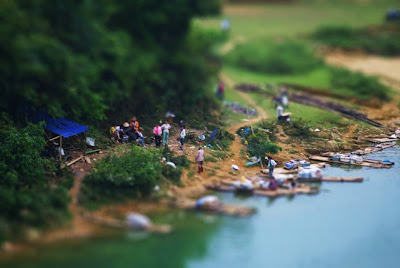

What's so perspective bending about this place is partly the scale of the city compared to the garden and how, though the garden isn't large, it can feel worlds away from the city next door. In fact, the garden is now smaller than it used to, having had sections amputated for the sake of the ever growing Tokyo. But now that it's designated both as a place of historical significance and a place of scenic beauty (one of only 7 such places in Japan to have acquired both statuses), it's protected from further intrusion. And at 300yen to enter, lots of people pay just to go in and have lunch (McDonald's no less... perhaps that's how they justify the 300yen entry fee??).

The other thing is that when I went (Wednesday afternoon), it was absolutely packed with older (read: retired) people with expensive cameras taking pictures of ducks... Seeing that I was also there snapping away and sensing a bit of irony, I dusted off the old 70-210mm (which I haven't used since I got my new Minolta lens) and shot some... well... flowers mainly, as the ducks weren't that interesting... The lily pond (below) was rather pretty though.


Patrick Hughes' Sea City, photo from PatrickHughes.co.uk
Which brings me to my second place of visit, the Bunkamura Art Museum in Shibuya where I duly waited 30min to get in to see their "Visual Deception" exhibit. The exhibit centred around art that is not what it seems, from painstakingly painted Trompe-l'œil ("Trick the eye") works like Pere Borrell del Caso's Escaping Criticism to M.C. Escher's or René Magritte's famous pieces to what you see above, Patrick Hughes' Sea City from his collection of "reverspective" art. It might not look like much from the picture, but the scene is painted on three pyramids that stick out towards you, with the small square of ocean horizon being the top of each pyramid. The tops and bottoms of the buildings lie on the pyramid seams and, as you view it from different angles (side to side and even up and down), the whole sense of perspective shifts with you. You can see it in action below.
Despite the crowds (being that it was Sunday) and photography being prohibited, it was great to go around and see all the art. I was particularly taken by pieces from Naoki Honjo's Small Planet collection in which Honjo uses special lenses to photograph things in such away as to make them look like miniature models. It intrigued so much so that I bought a book of his works. Then, when I got home last night, I did some digging around and found that it's a technique called tilt-shift miniature faking, using tilt-shift lens can actually slide on its mount in order to slightly change the perspective of the image that results on the film. That, coupled with tweaks to colour saturation and contrast, ends up producing an image with the sense of scale and nearly-artificial colour of models.
 Of course, while Honjo uses real film cameras and real tilt-shift lenses, computers can do most of the work on any picture these days. So I dug out some old (well, April 2009) photos to try it out on (above). They're probably not as good as those found in Honjo's book (which now seems destined for my coffee table). If I'm truly honest, the book was slightly tainted by my discovery that I could approximate his photos in 30 seconds with a computer and that other people do it as well, but Honjo really does have an eye for what makes a realistic miniature (is that an oxymoron?) as well as some truly inspiring angles. And there are pictures from all over the world, including one I recognize from Hong Kong.
Of course, while Honjo uses real film cameras and real tilt-shift lenses, computers can do most of the work on any picture these days. So I dug out some old (well, April 2009) photos to try it out on (above). They're probably not as good as those found in Honjo's book (which now seems destined for my coffee table). If I'm truly honest, the book was slightly tainted by my discovery that I could approximate his photos in 30 seconds with a computer and that other people do it as well, but Honjo really does have an eye for what makes a realistic miniature (is that an oxymoron?) as well as some truly inspiring angles. And there are pictures from all over the world, including one I recognize from Hong Kong.Anyways, it was a good few days out and I leave you with some more samples of my tilt-shifted photos.




2 comments:
Wow, amazing techniques! They do make the pictures look like miniatures. I must say that after reading about the different types of lens they used in the past, we can do that all on computer modification. e.g. the shift lens effect can be done with "distort" function which I have been using all along to "correct" the skew when we have to take a picture of a Sign from the side. I did not realize they had a special lens for that. Well, technology have saved us a bundle.
Dad
Yeah, but the old ways still work better, like if you correct a skewed picture, you have to crop bits and pieces off the sides, where as lens will shoot something onto film as is....
But you're right, about 90% of it can be done on a computer now... which might explain why it seems like everyone's got an SLR now heh...
Post a Comment